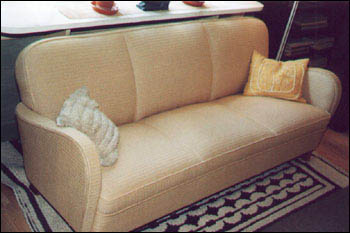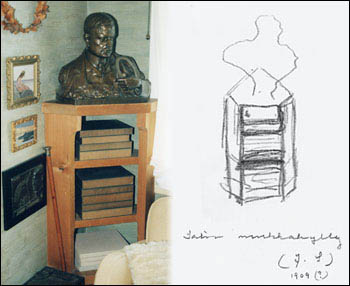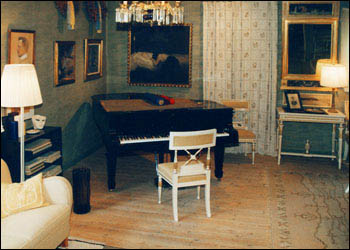In front of the window opposite the vestibule there is a grey sofa which was bought for the Sibeliuses’ apartment in Kammiokatu in the autumn of 1939.

To the left of the sofa there is sturdy corner shelving. This was designed by Jean Sibelius and is full of pieces of music belonging to Aino Sibelius.

The Steinway grand piano on the right is a 50th birthday present. The costs of it were met by 144 music lovers. The bailiffs laid claim to it soon after the birthday celebrations, but a collection organised by Ida Ekman helped to prevent it from being taken away.
All the members of the Sibelius family played on this grand piano. Sibelius mostly played it at night when he was trying out his ideas for compositions. Wilhelm Kempff gave private recitals for the Sibeliuses in 1923, and Kosti Vehanen played it when Marian Anderson sang to the composer in 1933. Sibelius himself played the orchestral parts of his violin concerto on the piano when Isaac Stern played the concerto at Ainola in 1951, and on this piano Emil Gilels played Shostakovich's preludes and fugues to Sibelius in 1952. The piano is still in good shape. Its tone is lyrical and very beautiful.

The mirror and the chandeliers are from the estate of Sibelius's uncle, the sea captain Johan Matias Fredrik. The old chest in the right hand corner of the drawing room was inherited by Aino Sibelius from her father, General Alexander Järnefelt.
Behind the grand piano there is a large and gloomy oil painting, A Prayer to God, by Oscar Parviainen (1880-1938).
The shelves below Parviainen's painting contain items given in honour of Sibelius, for example congratulatory compositions by Shostakovich and Prokofiev. The cases on the piano also contain congratulatory items. The curtains on the right conceal a door which opens onto stairs leading down to the balcony.

Below the mirror there is an oblong photograph of the Italian coast, from Rapallo to Portofino. The Sibeliuses spent over two months in Rapallo in the spring of 1901, and the composer went for walks along this part of the coast when he was writing his second symphony. The white and gilded Empire style furniture was designed especially for the room and has been there since the house was built. The Empire furniture was made at Lindholm's joinery shop in Fabianinkatu, Helsinki. Mr Lindholm visited the castle of Turku to make cardboard templates for the furniture. The actual joinery work was done by Karl-Evert Kavander (1881-1970), who was employed by Lindholm during the years 1900-17. The work took about a year. On the Empire table there is a photograph of Queen Victoria of Sweden with a dedication. She visited Finland in 1925, and Aino Sibelius was invited to join her entourage during the visit. The neo-rococo table is a gift from the estate of Martha Tornell, a family friend who died in 1923. The large woollen carpet under the table was bought by the Sibeliuses at Pirtti Oy on 10th October 1929 for 2,080 marks (490 euros). To the left of the door there is an oven with green tiles designed by Lars Sonck (1870-1956).
> Art in the drawing room at Ainola



